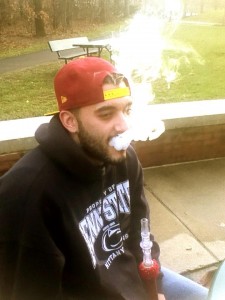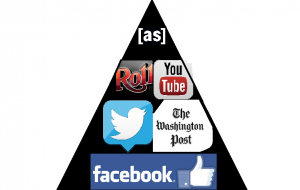Content Producer and new media guru Andrew Knight spoke to journalism students at George Mason University on Thursday, March 28 about the Storify platform.
Journalism Program Coordinator Steve Klein brought Knight to campus to help his students better understand how to fully utilize the medium, and answer any questions about complications.
I had never used Storify before this presentation. Knight walked us through step-by-step how to create a headline and story grafs. He also showed us the social media tool built into the platform and how to effectively use it to supplement our story context.
Knight uses Storify on a daily basis for his job at Hanley Wood, a publishing company. He said a lot of notable media companies are primarily using Storify to produce their stories.
I thoroughly enjoyed the presentation because I had not heard of Storify previously. Now I can’t stop! Creating stories is easy and fun with Storify. It takes me back to when I used to create pages for print stories with Adobe InDesign.
After this tutorial, I decided I’m going to use Storify for my story for this class since I am the editor this round. I think it will help improve the story because it will include social media posts, and multimedia.
This round begins my turn to be the Writer/Editor. I’m still doing a lot of research because my story is going to involve a lot of different information and sources (we are going to be writing about the I-95 HOT lanes). The reporting/researching portion of this story, I suspect, will be the hardest. However, it’s never too early to consider different story structures, to figure out which I can use to best report the issue.
Best case scenario I can think of so far is that I’ll have enough information from the construction aspect, the tolling/financial aspect, and the people effected by it aspect to be able to use the diamond structure. It’s not going to be hard news because people are already know about it, and hard news stories about it have been written already. Instead, I want to take a humanized angle on the story. Therefore, it is my goal to find commuters or residents that will be affected by the HOT lanes often and use their opinions on the matter as anecdotes to open and close my story. I will, of course, still include logistical information and new developments, but the hard news approach has really been overdone for this topic and I want to write something different. This means I will be throwing out the beloved inverted pyramid structure I know and love so much–haha–!
Kevin Goldberg’s presentation on “The 7 Deadly Sins” of journalism really floored me. Who knew that words such as allegedly could be used incorrectly?! I was surprised to learn how doubling checking every word and implication is of the utmost importance when writing stories. Goldberg also surprised me when he discussed the over-use of the Fair Use act and Creative Commons. I must admit that I am guilty of relying on them because I know I can in college because it’s for educational purposes. However, the real world doesn’t allow for that kind of leeway, so I’m trying to mentally prepare for the legal hoops I’m going to need to jump through to convince people to let me use some of their work when it’s necessary.
Applying the topics Goldberg covered in his lecture to our group blogs, I’ve taken my own photos of the construction for Campus Drive to avoid using copyrighted materials. However, I think I am still going to use the diagrams from the university and the county but credit them directly. I believe this will make our story more credible because we are drawing information from the people who designed the project– I’m not simply creating my own interpretation of what it will look like.
I am the multimedia editor for the first story Transporters Fairfax is working on. We are working on a story about Campus Drive, a new road that’s being built at GMU to connect the main campus with West Campus’ parking lot.
During my research, I’ve found that the most useful tools for me can be found through the Fairfax County website. Since GMU has to work with the county on this project, the two have made many documents and blueprint photos public online. I can easily recreate these images or borrow them if I give credit.
I’m thinking about doing a slideshow showing a bird’s eye image of what the campus looked like before and what it will look like after Campus Drive is built. The public library here has a lot of documented photos and I’m hoping to find one from the campus pre-construction on this project.
Something like this without the writing:
Like Professor Miller said in class, I’d be pissed if I hired someone who took photos I could take. Photography is an art and with any art form there are techniques and methods which must be learned. Whether learned in class or self-taught, it doesn’t matter, but practice does.
Mark Briggs’ section on visual storytelling hits points that our speakers noted in class, as well as some of what Josh presented. Briggs quotes Colin Mulvany: “Photography is all about moment.” Anticipating moments were an important part of our speakers’ tips. Even though this often requires waiting around, the result is well worth it because the photo (hopefully) is one that publications will use because they are so striking and different. Briggs also encourages taking as many photos as necessary. Digital cameras don’t require dealing with filmstrips so it’s better to have a lot of photos to choose from then picking the best from a small bunch; the more options available the more likely to get a unique shot.
Something I’ve learned from all these numbers being thrown out is that a high amount of pixels is best. It makes the shots clearer and more defined, which is very appealing to the eye. Briggs says that most computer screen are set to 72 pixels per inch, so photos should be edited to best fit this resolution so that the photo is perceived clearly.
The Creative Commons project seems complicated. The way I see it, if you’re working for a publication you need to produce all of your own material. Borrowing another person’s photo for a story seems lazy and unoriginal, and I don’t see why anyone would want those adjectives attached to their name. If a logo of a company is necessary for a story photo, you should ask the company if you may use their logo in a creative way. For example, the below photo features the Starbucks logo that has been altered by Ed Levine, the topic person in a Washington Post article.
This is a creative way to use a logo, and since the Washington Post didn’t even actually make this, Levine did, then they can get away with it’s importance to the story but originality with a logo photo.
After reading Mark Briggs’ chapter on crowd-powered collaboration, journalism seems to be easier than it once was, contrary to Phil Meyer’s quote: “They are raising the ante on what it takes to be a journalist”.
Briggs’ point that journalism is becoming more about social interaction and feedback than it once was made me think about the history of journalism. Did journalists in the nineteenth century write with the intention of not receiving feedback or social discussion? I can’t help but think no. The soul of journalism is clearly portrayed through what exactly what is happening with the rising popularity of blogs. Recording new and impacting events and stories that will ultimately reach word of mouth; blogs just close the elapsing time gap between printed stories and audience feedback and conversation.
I will agree with Meyer’s quote when it comes to multimedia abilities of journalists and the time they devote now to instant updates of news. Because of social media on the internet, news has been sped up and ambitious, committed journalists want to keep up as best they can. All the while, they realize the emphasis of attention grabbing visuals to help improve readership, so having experience in these photographic, videographic, interactive additives makes a journalist more attractive to editors and publishers.
Going back to the chapter though, I thought using citizens to improve the quality of news is fantastic. The example featuring Lila King from CNN helped me understand how exactly the whole thing works. It’s great for publications because it’s like having hundreds of reporters everywhere, but you don’t have to pay them. The only pit fall I can foresee with this is making sure that information from citizens is fact. Fact checking has always been important, but it’s crucial when journalists don’t even know the people they are receiving updates from.
King said that the iReport on CNN has become like a community, so perhaps having repeat sources can build trust but regardless, fact checking is always the most important step in revising stories.
Having blogs encourages a dialogue between the journalist and the public, which makes news less intimidating and authoritative. When people feel as if their opinion will be heard, they are more willing to be loyal to a specific journalist or publication.
I read an article about a reporter who got bought out by The New York Times, and there is controversy over his Twitter account. This Twitter tag includes the acronym ‘nyt’ and The New York Times is claiming that his Twitter and his thousands of followers belong to them. This raises concerns with blog reputations because there’s a question that hasn’t been answered yet: Do journalists’ social media encompass their employer or is it their property to showcase their work and beliefs in one social media outlet?
Filed under: Uncategorized | 1 Comment
In warmth of today’s near 70 degree weather, one group of George Mason University students are participating in a cultural pastime that began in the Middle East and remains a social ritual in the twenty-frist century.
This student, who wishes to be unnamed, is blowing Skittles flavored shisha smoke as it was his turn in the rotation of the hookah circle. The smokers said there are hundreds of exotic shisha flavors such as Passionfruit and Mint. They also said rotating the hookah hose, which is how the shisha is smoked, is an unwritten rule for participating.
Some smokers disagreed, however, on the topic of it’s affects compared to cigarettes. While both agreed that hookah has less chemicals, such as tar, that cigarettes have, they were at a disagreement on whether or not it was addicting or as harmful to health as cigarettes are.



